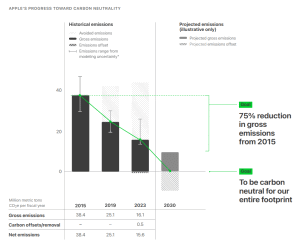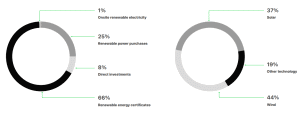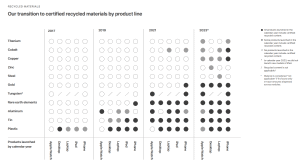Can Apple Win The Race to Net Zero With Its Bold Clean Energy Plan?
October 11, 2024
Apple’s ambitious clean energy plan has positioned the company as a leader in the tech industry’s fight against climate change. With a clear goal of becoming carbon neutral across its entire supply chain by 2030, Apple is accelerating its data centers’ transformation while aligning with its broader net-zero emissions strategy.
Will the company make it and reach its bold carbon neutrality goals? Let’s take a closer look at how the iPhone maker plans to achieve its ambitious climate targets.
Apple’s Bold Path to a Cleaner, Greener Future
Apple’s journey to 2030 revolves around reducing its emissions across Scope 1, 2, and 3 categories by 75%. The tech giant will then offset the remaining emissions with carbon removal initiatives.
Apple has already achieved significant milestones in reducing its emissions, cutting them by over 55% since 2015. The company’s approach involves decarbonizing its three main emission sources: materials, electricity, and transportation. By addressing these three areas, Apple aims to achieve a balance between reducing its footprint and supporting renewable energy solutions.

A critical component of Apple’s clean energy strategy is its shift toward 100% clean energy across its facilities. The company reached a significant milestone in 2018 by sourcing 100% renewable energy for its offices, retail stores, and data centers. This progress laid the foundation for Apple’s broader commitment to become carbon neutral throughout its supply chain, setting an example for other companies to follow.
Quenching Data Center’s Thirst for Power
Data centers are among the most energy-intensive operations for tech companies. Apple’s data centers require substantial resources to cool the servers and IT equipment, making them a key focus for the company’s clean energy initiatives.
One of Apple’s key efforts is optimizing its server designs for improved energy efficiency, saving over 36 million kilowatt-hours annually in 2023 alone. The tech giant’s data centers consumed 2.344 billion kWh of electricity in the same year, up from the previous year’s 2.14 billion.
Despite the massive energy use, 100% of this electricity came from renewable sources, including solar, wind, biogas, and low-impact hydropower. Additionally, its colocation data center energy use dropped slightly to 483 million kWh, though overall colocation power consumption increased.

To sustain its clean energy goals, Apple is building its own renewable power projects and collaborating with utilities. The company’s data centers have been powered by renewable energy since 2014, leading to a 54% reduction in greenhouse gas emissions. Supporting services like iCloud and Siri, Apple serves one billion users globally.
The company’s energy-efficient cooling systems also play a significant role in minimizing energy usage, further boosting the overall efficiency of its data centers.
Apple’s data center acceleration plays a crucial role in the company’s overall net-zero emissions plan. By maintaining 100% clean energy at its data centers, Apple reduces the carbon footprint associated with its digital infrastructure. This combination of clean energy and energy efficiency is essential to Apple’s broader goal of achieving carbon neutrality by 2030.
Green Inside and Out: Recycled Materials and Product Energy Efficiency
A key part of Apple’s clean energy plan involves the transition to using 100% recycled and renewable materials in its products. The iPhone maker has made significant progress in this area.
In 2023, 22% of materials in shipped products were from recycled or renewable sources. By 2025, Apple plans to use 100% recycled cobalt in all Apple-designed batteries and 100% recycled gold plating in its circuit boards. It also aims to use recycled rare earth elements in magnets.
The company has prioritized 15 key materials, including aluminum, cobalt, gold, and lithium, based on environmental, social, and supply chain impacts. These materials represented 87% of the total product mass shipped in 2023, advancing Apple’s sustainability goals.

Product energy efficiency is another critical element of Apple’s carbon emissions reduction. As the use of Apple products accounts for 29% of its gross carbon footprint, the company continues to innovate in product design to enhance energy efficiency. Since 2008, Apple has cut overall energy use across its product lines by more than 70%.
The transition to Apple Silicon chips, particularly in its Mac devices, has driven significant energy efficiency improvements. For instance, the M2 Mac mini reduced energy use while enhancing performance, and the A15 Bionic chip eliminated the need for internal fans, further reducing energy consumption.
Apple’s efforts have led to all eligible products receiving ENERGY STAR ratings, reinforcing their superior energy efficiency.
How Apple’s Supply Chain Partners Are Going Green
Apple’s net-zero emissions plan goes beyond its internal operations, extending to its supply chain. The Supplier Clean Energy Program, launched in 2015, is a cornerstone of Apple’s decarbonization efforts. This initiative encourages suppliers to transition to 100% renewable electricity in the production of Apple products.
- As of March 2024, over 320 suppliers, representing 95% of Apple’s direct manufacturing spend, have committed to using 100% renewable electricity.
To further accelerate progress, Apple has integrated renewable energy requirements into its Supplier Code of Conduct, requiring all direct suppliers to adopt clean energy practices. This shift is not only a critical step toward achieving Apple’s 2030 carbon neutrality goal but also serves as a blueprint for other companies aiming to reduce their carbon footprints.
Apple’s commitment to driving industry-wide change makes its supply chain decarbonization a model for global corporate sustainability efforts.
Carbon Removal Credits: The Final Piece in Apple’s Climate Puzzle
While Apple’s primary focus is on reducing emissions, some emissions remain unavoidable with current technologies. For those emissions, Apple is investing in carbon offset projects, including nature-based solutions like forest restoration and mangrove planting. These projects aim to sequester carbon, with an emphasis on transparency, permanence, and measurable impacts.
In March 2024, Apple’s initial $200 million investment in carbon removals through its Restore Fund has grown to $280 million. The fund focuses on supporting nature-based carbon removal projects.
The company’s roadmap includes a clear vision for achieving long-term sustainability goals, including a 90% reduction in emissions by 2050. Though challenges remain, Apple’s leadership in clean energy, data center acceleration, and net-zero emissions serves as a powerful example of how corporations can drive meaningful change in the fight against climate change.
Search
RECENT PRESS RELEASES
Related Post




